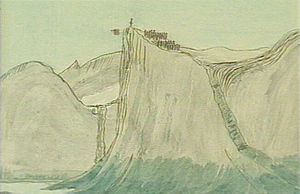Pisissarfik
| Pisissarfik | ||
|---|---|---|
|
A Viking is thrown from the summit of Pisissarfik. Watercolor by Aron von Kangeq (1822–1869) |
||
| height | 1220 m | |
| location | North shore of Kapisillit Fjord, West Greenland | |
| Coordinates | 64 ° 27 ′ 0 ″ N , 50 ° 35 ′ 0 ″ W | |
|
|
||
The Pisissarfik (also outdated: Pisigsarfik ) is a 1220 meter high mountain in West Greenland , which has gained importance as an archaeological site. Pisissarfik also plays a major role in the Inuit legends .
geography
The mountain is located near the settlement Kapisillit on the north bank of Kapisillit Kangerluaq (Danish: Godthåbs- Fjord ) about 150 kilometers northeast of the Greenlandic capital Nuuk in the area of the municipality Sermersooq . While it rises relatively gently from the land side, the Pisissarfik falls on the sea side in a steep cliff and is one of the most striking mountains in the region due to its striking shape.
history
Along the Kapisillit Fjord there were farms of the so-called West Settlement (Vestribyggð) of the Grænlendingar , the Scandinavian settlers in Greenland , until around 1350 . At this time there were frequent conflicts with the local Inuit ; It is believed that the clashes (along with climate change) were one of the reasons for the disappearance of the Scandinavians from the region and later from all of Greenland. The Greenlandic name “Pisissarfik” means “shooting range” and is derived from a legend from this period.
Legend
An Inuk and a Viking climbed to the summit and organized from there a shooting competition with a bow and arrow to a spanned on the shore of the fjord sealskin . The Inuk won and brought the loser over the cliff to his death.
According to Inuit mythology, the last decisive battle between the hostile groups that resulted in the extermination of the Nordic settlers took place at the foot of the mountain. For a long time, the population also believed that the graves found at the foot of the cliffs were the resting place of the Grænlendingar killed in this fight. In fact, scientists from the National Museum of Denmark who examined the site from 1945 to 1952 did not find the remains of Nordic settlers, but Inuit graves dated to the 16th to 17th centuries.
Archaeological finds
The tombs contained human bodies preserved through natural mummification , similar to the mummies of Qilakitsoq . Three children were found in one grave, all under one year old. In another lay two women and two children wrapped in reindeer skins . The clothes of the mummies, parkas made of bird and seal skin, and kamit (singular kamik , sealskin boots) were also well preserved.
The Pisissarfik also played an important role in the Christianization of the region in the 18th century: on Pentecost Sunday 1749, the first mass was celebrated at its foot .
literature
- T. Ammitzbøll, M. Bencard, J. Bodenhoff, Rolf Gilberg, A. Johansson, Jørgen Meldgaard, Gerda Møller, Rigmor Møller, E. Svejgaard, L. Vanggaard: Clothing . In: Jens Peder Hart Hansen, Jørgen Meldgaard, Jørgen Nordqvist (eds.): The Greenland Mummies . British Museum Publications, London 1991, ISBN 0-7141-2500-8 , pp. 116-149 .
Web links
- Siulleq Pisissarfik. Archived from the original on March 3, 2007 ; accessed on March 16, 2008 (pictures of the Pisissarfik).

